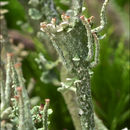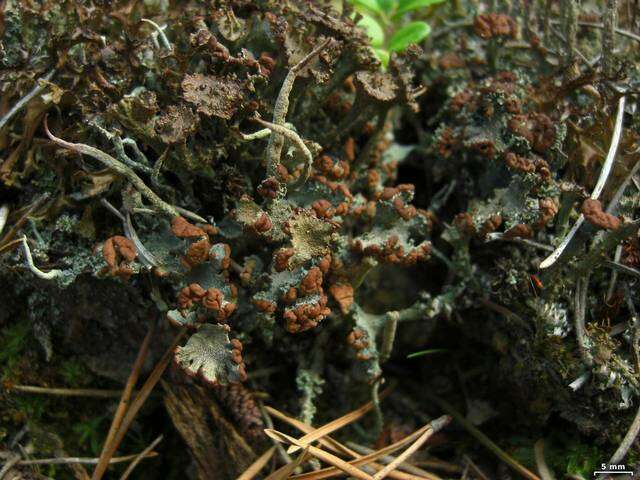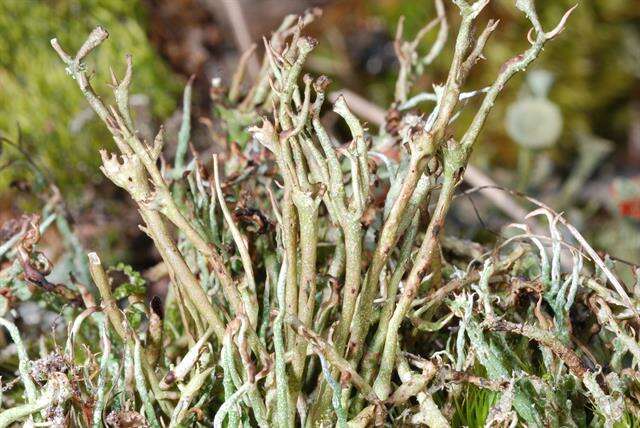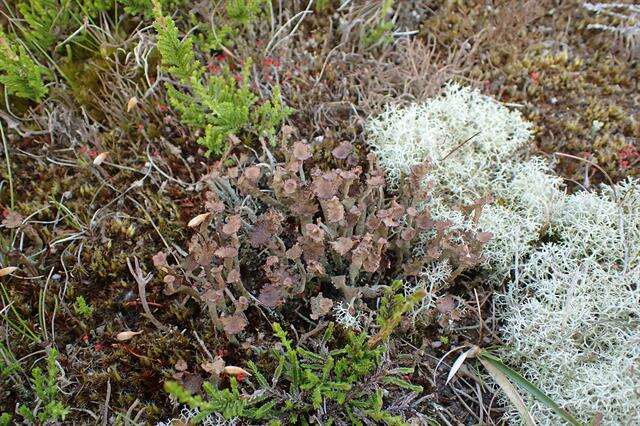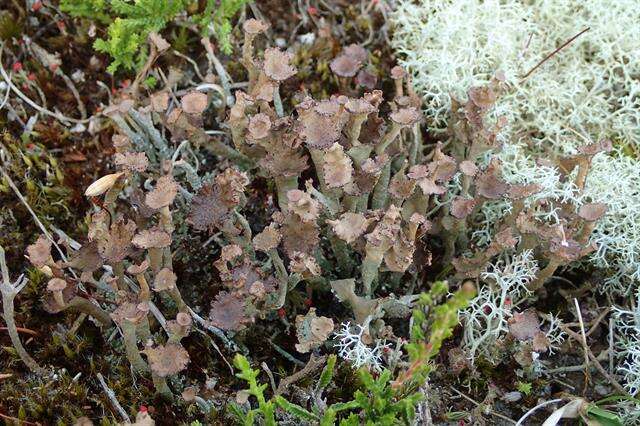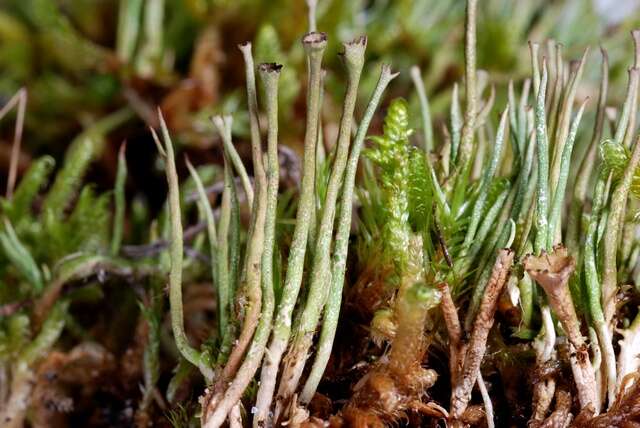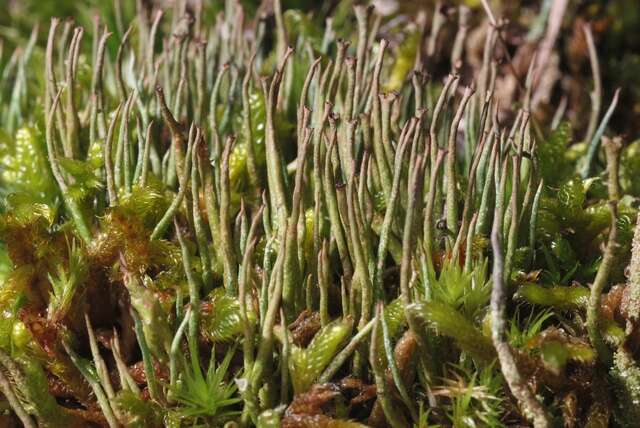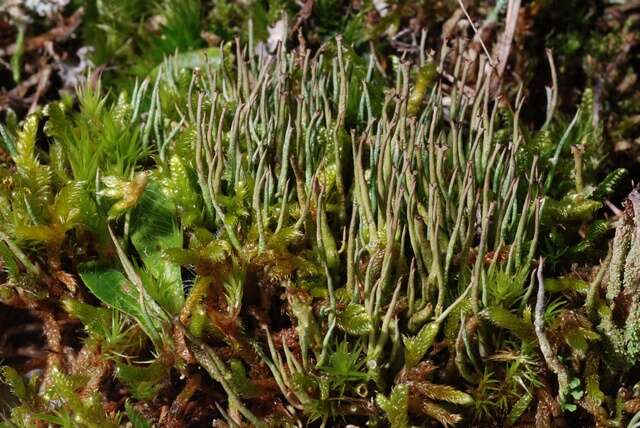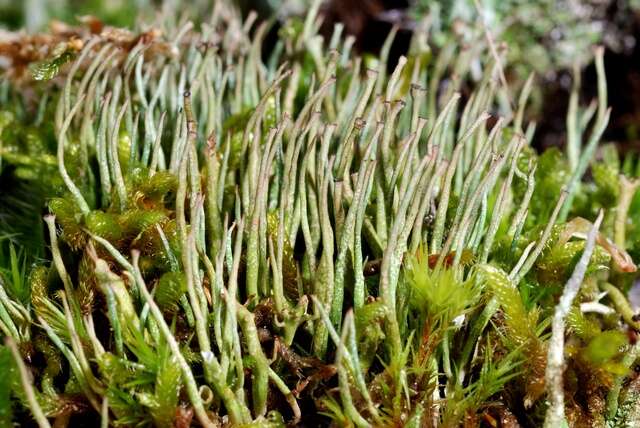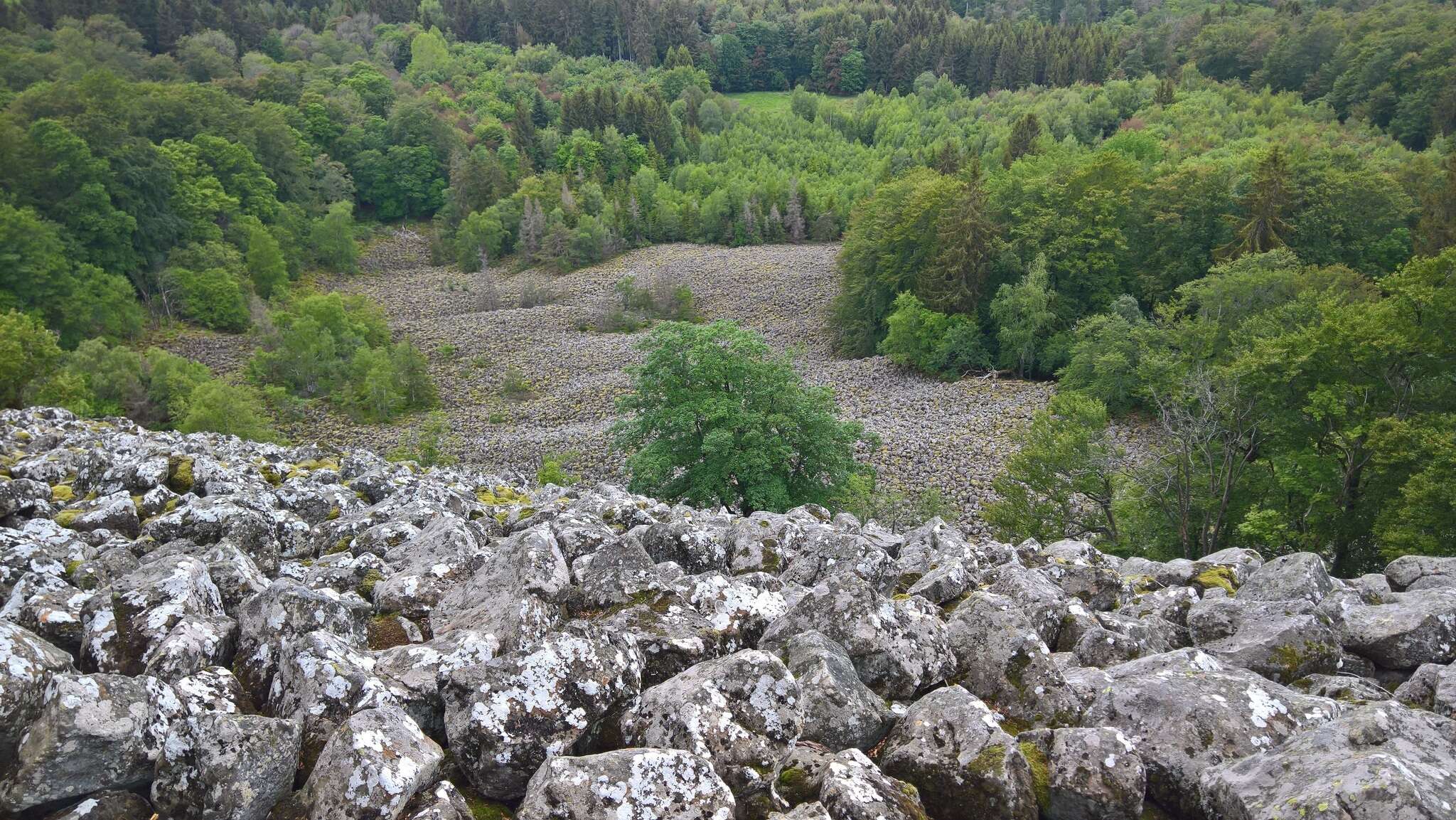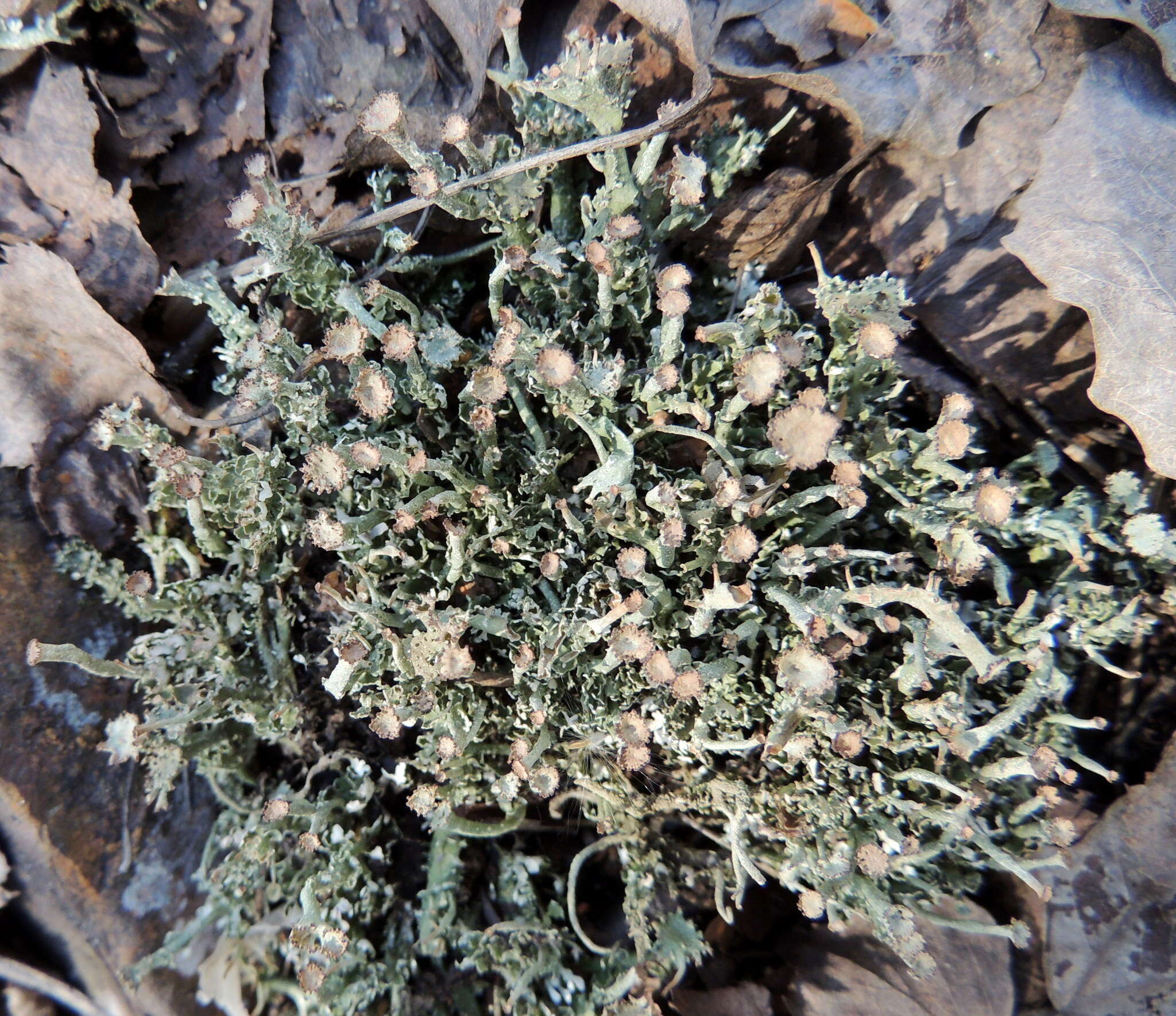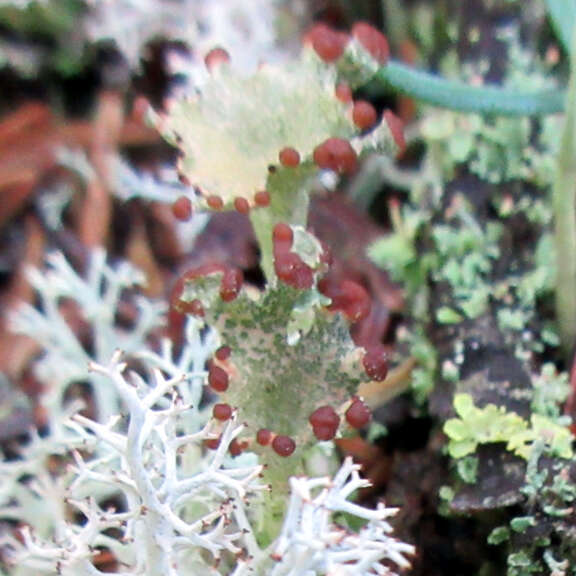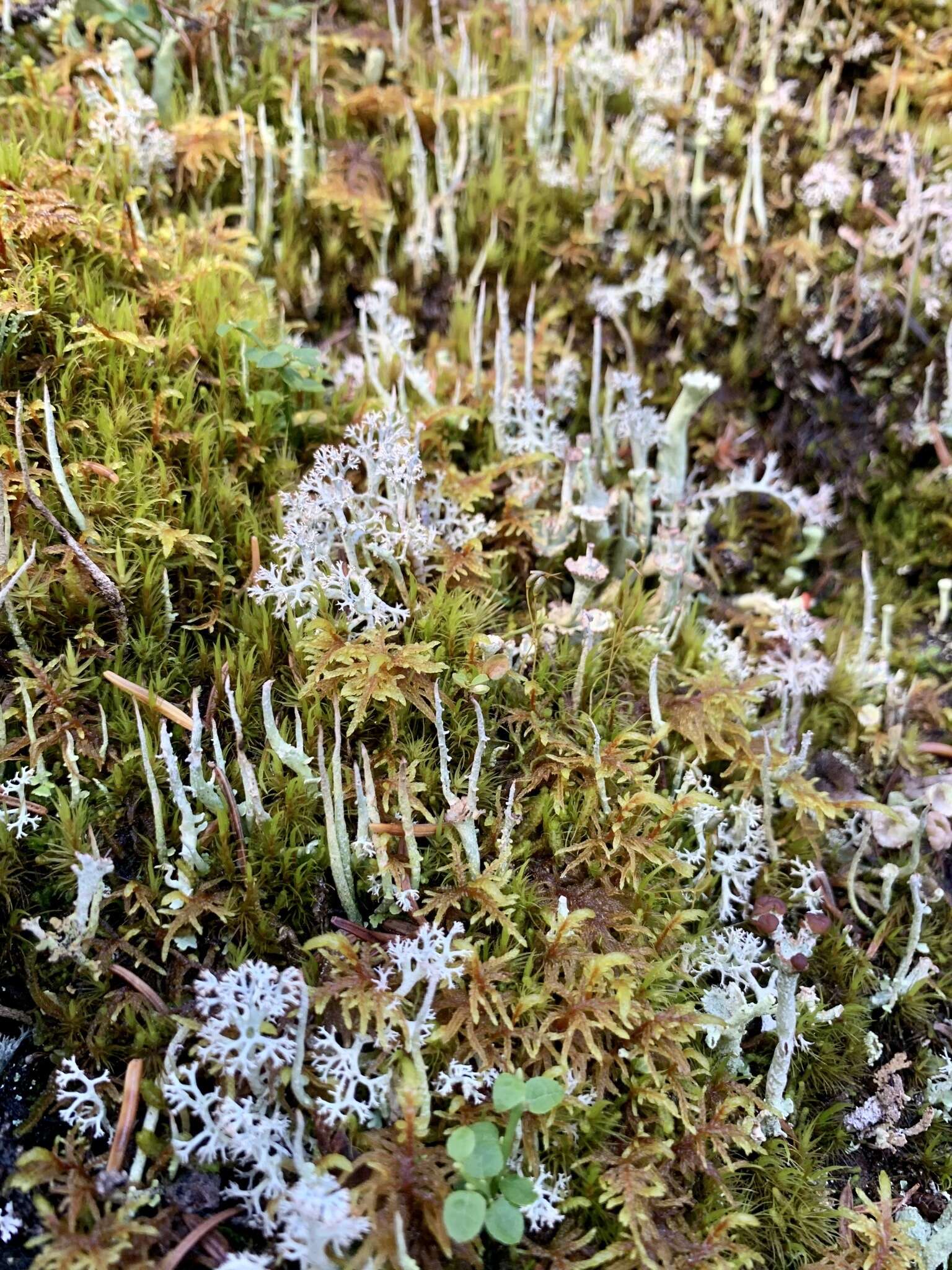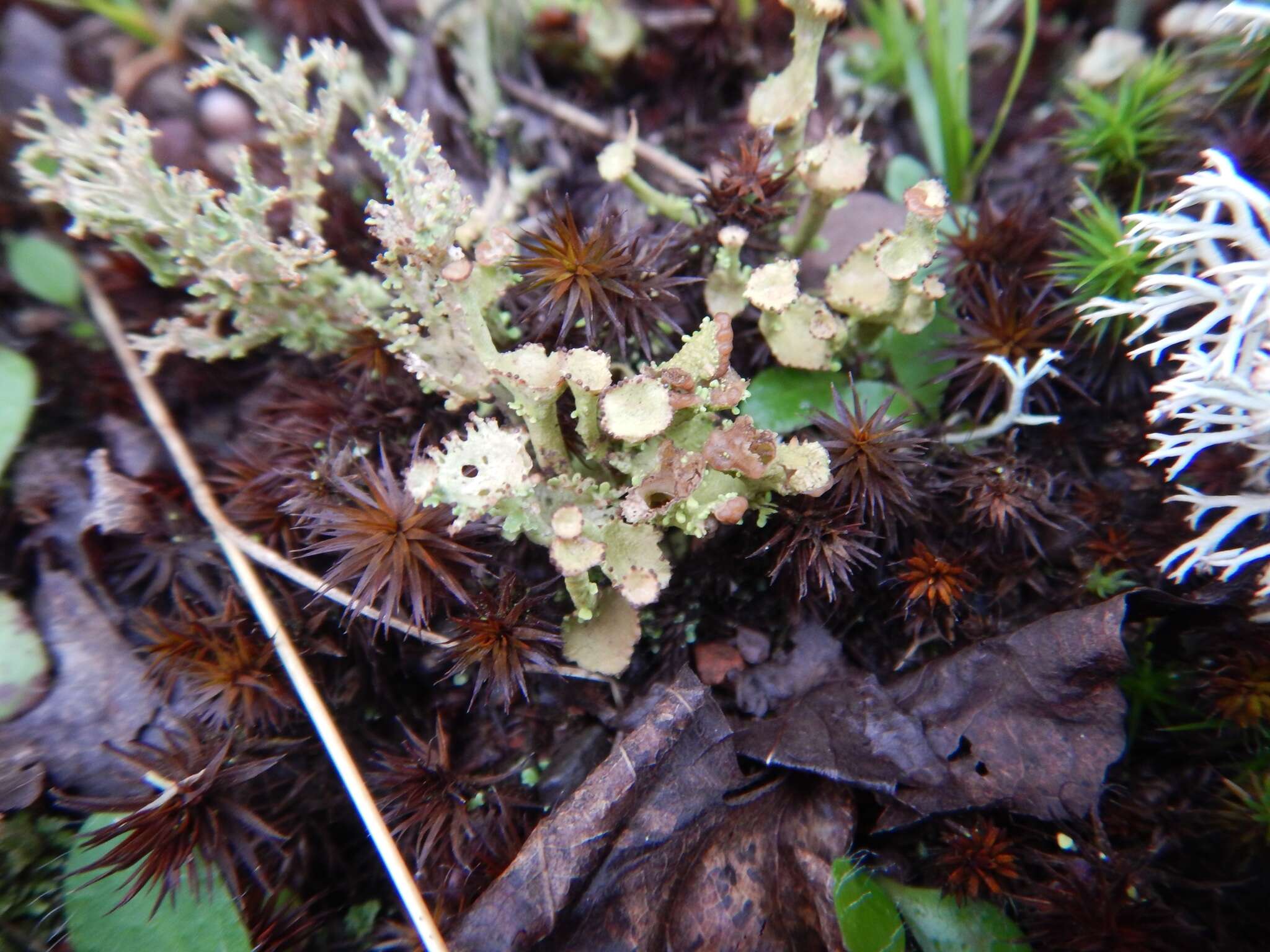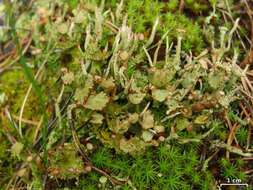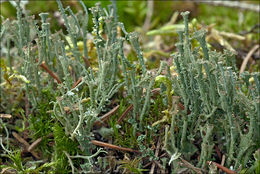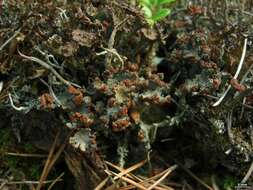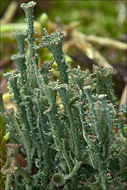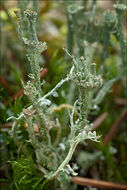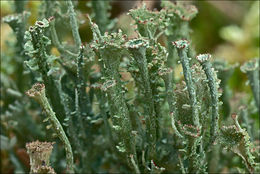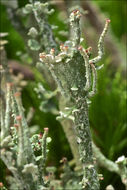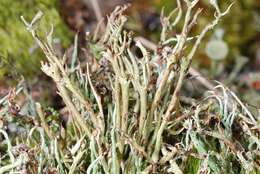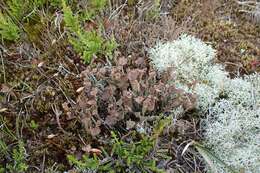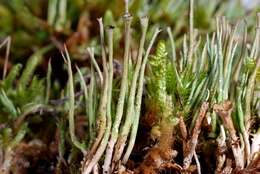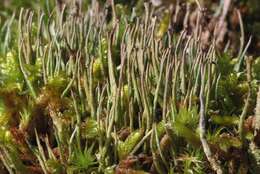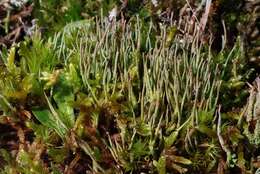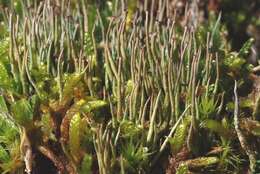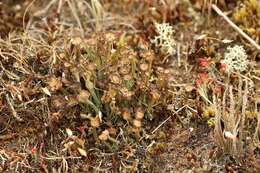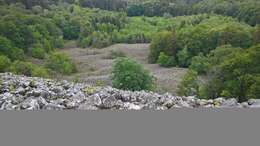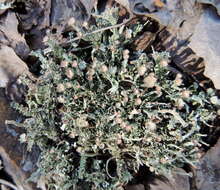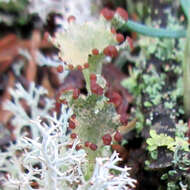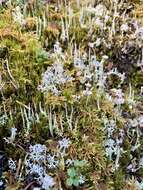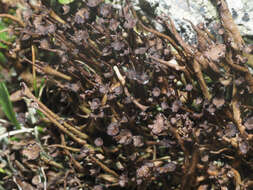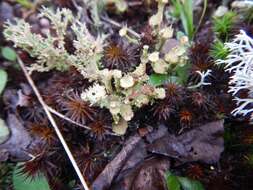-
Mushroom Observer Image 239056: Cladonia gracilis subsp. turbinata
-
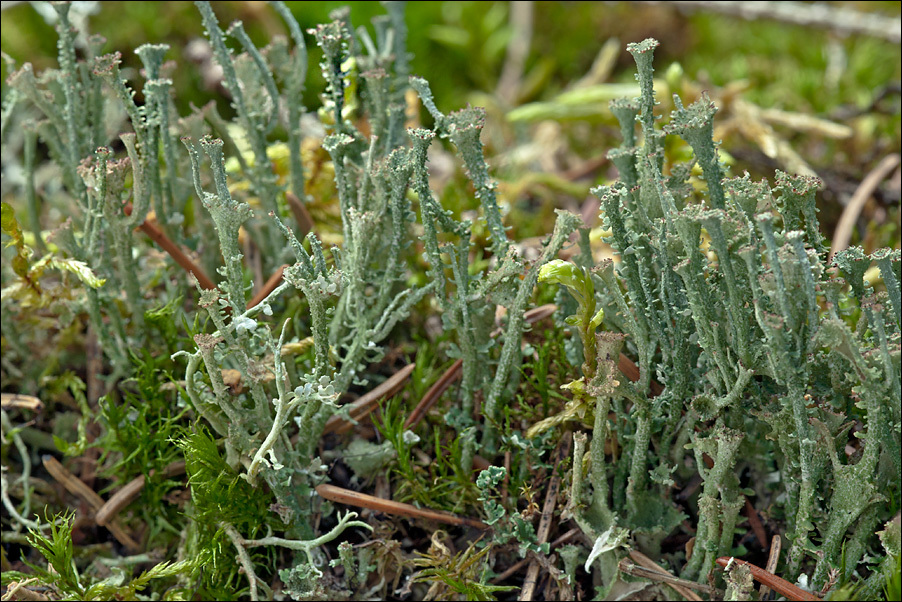
Habitat: abandoned stony pasture, moderately southeast inclined mountain slope with some Picea abies and Corylus avellana bushes, overgrown calcareous, stony ground, however possibly somewhat acid; very shallow soil layer, more or less open place, but mostly in shade of high Picea abies trees,exposed to direct rain, average precipitations ~ 3.000 mm/year, average temperature 7-9 deg C, elevations 590 m (1.950 feet), alpine phytogeographical region. - Substratum: stony ground, among low grasses and mosses. - Comment: Determined by habitus and habitat only. No chemistry tests done. This species is very variable according to literature. Usually published pictures show much less podetia squamules and less branched habitus. Hence I have doubts the determination is correct. On other side. Ref.:(1) shows very similar habitus. Also I was unable to find a better alternative with characteristically almost absent ground squamules and typical 'cups' of the podetia. - Ref.: (1) W. Rothmaler, Exkursionsflora von Deutschland, Vol.1, Niedere Pflanzen, Elsevier, 3. Auflage (1994), p 604. (2) C.W. Smith, et all, The lichens of Great Britain and Ireland,The British Lichen Society (2009), p 329. (3) F.S. Dobson, Lichens, The Richmonds Publishing Ca. LTD (2005), p 140. (4) V. Wirth, Die Flechten Baden-Wrttembergs, Vol.1. Ulmer (1995), p 327.
-
Mushroom Observer Image 239057: Cladonia gracilis subsp. turbinata
-

Habitat: abandoned stony pasture, moderately southeast inclined mountain slope with some Picea abies and Corylus avellana bushes, overgrown calcareous, stony ground, however possibly somewhat acid; very shallow soil layer, more or less open place, but mostly in shade of high Picea abies trees,exposed to direct rain, average precipitations ~ 3.000 mm/year, average temperature 7-9 deg C, elevations 590 m (1.950 feet), alpine phytogeographical region. - Substratum: stony ground, among low grasses and mosses. - Comment: Determined by habitus and habitat only. No chemistry tests done. This species is very variable according to literature. Usually published pictures show much less podetia squamules and less branched habitus. Hence I have doubts the determination is correct. On other side. Ref.:(1) shows very similar habitus. Also I was unable to find a better alternative with characteristically almost absent ground squamules and typical 'cups' of the podetia. - Ref.: (1) W. Rothmaler, Exkursionsflora von Deutschland, Vol.1, Niedere Pflanzen, Elsevier, 3. Auflage (1994), p 604. (2) C.W. Smith, et all, The lichens of Great Britain and Ireland,The British Lichen Society (2009), p 329. (3) F.S. Dobson, Lichens, The Richmonds Publishing Ca. LTD (2005), p 140. (4) V. Wirth, Die Flechten Baden-Wrttembergs, Vol.1. Ulmer (1995), p 327.
-
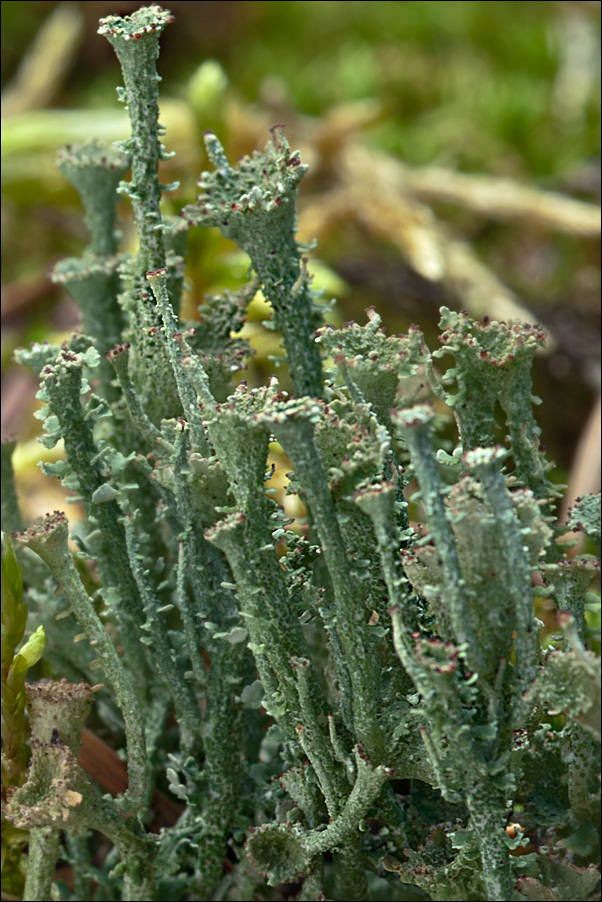
Habitat: abandoned stony pasture, moderately southeast inclined mountain slope with some Picea abies and Corylus avellana bushes, overgrown calcareous, stony ground, however possibly somewhat acid; very shallow soil layer, more or less open place, but mostly in shade of high Picea abies trees,exposed to direct rain, average precipitations ~ 3.000 mm/year, average temperature 7-9 deg C, elevations 590 m (1.950 feet), alpine phytogeographical region. - Substratum: stony ground, among low grasses and mosses. - Comment: Determined by habitus and habitat only. No chemistry tests done. This species is very variable according to literature. Usually published pictures show much less podetia squamules and less branched habitus. Hence I have doubts the determination is correct. On other side. Ref.:(1) shows very similar habitus. Also I was unable to find a better alternative with characteristically almost absent ground squamules and typical 'cups' of the podetia. - Ref.: (1) W. Rothmaler, Exkursionsflora von Deutschland, Vol.1, Niedere Pflanzen, Elsevier, 3. Auflage (1994), p 604. (2) C.W. Smith, et all, The lichens of Great Britain and Ireland,The British Lichen Society (2009), p 329. (3) F.S. Dobson, Lichens, The Richmonds Publishing Ca. LTD (2005), p 140. (4) V. Wirth, Die Flechten Baden-Wrttembergs, Vol.1. Ulmer (1995), p 327.
-
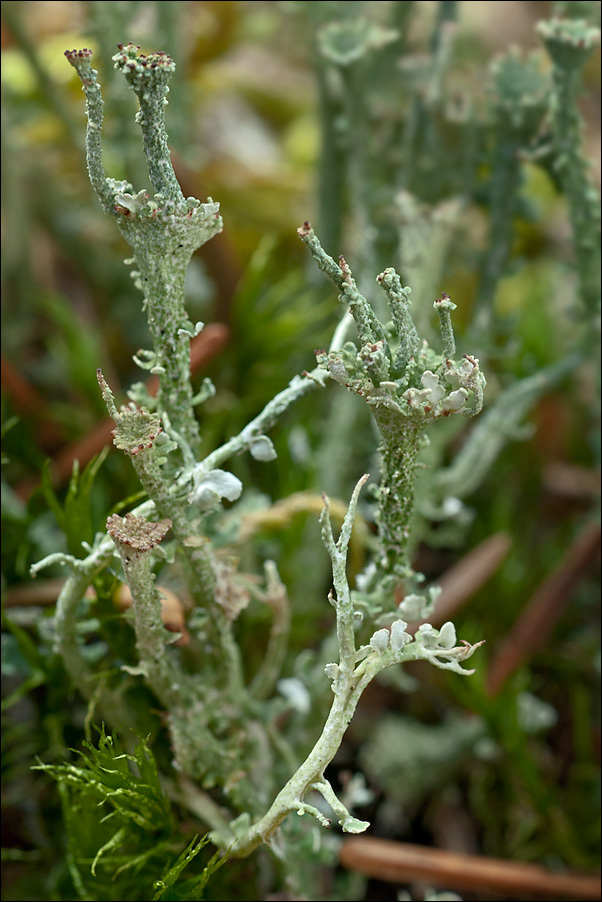
Habitat: abandoned stony pasture, moderately southeast inclined mountain slope with some Picea abies and Corylus avellana bushes, overgrown calcareous, stony ground, however possibly somewhat acid; very shallow soil layer, more or less open place, but mostly in shade of high Picea abies trees,exposed to direct rain, average precipitations ~ 3.000 mm/year, average temperature 7-9 deg C, elevations 590 m (1.950 feet), alpine phytogeographical region. - Substratum: stony ground, among low grasses and mosses. - Comment: Determined by habitus and habitat only. No chemistry tests done. This species is very variable according to literature. Usually published pictures show much less podetia squamules and less branched habitus. Hence I have doubts the determination is correct. On other side. Ref.:(1) shows very similar habitus. Also I was unable to find a better alternative with characteristically almost absent ground squamules and typical 'cups' of the podetia. - Ref.: (1) W. Rothmaler, Exkursionsflora von Deutschland, Vol.1, Niedere Pflanzen, Elsevier, 3. Auflage (1994), p 604. (2) C.W. Smith, et all, The lichens of Great Britain and Ireland,The British Lichen Society (2009), p 329. (3) F.S. Dobson, Lichens, The Richmonds Publishing Ca. LTD (2005), p 140. (4) V. Wirth, Die Flechten Baden-Wrttembergs, Vol.1. Ulmer (1995), p 327.
-
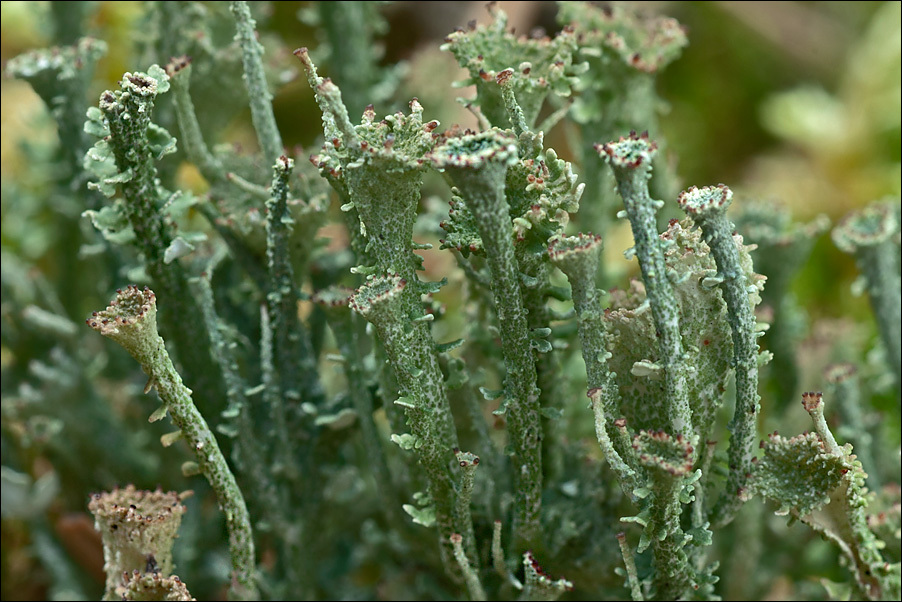
Habitat: abandoned stony pasture, moderately southeast inclined mountain slope with some Picea abies and Corylus avellana bushes, overgrown calcareous, stony ground, however possibly somewhat acid; very shallow soil layer, more or less open place, but mostly in shade of high Picea abies trees,exposed to direct rain, average precipitations ~ 3.000 mm/year, average temperature 7-9 deg C, elevations 590 m (1.950 feet), alpine phytogeographical region. - Substratum: stony ground, among low grasses and mosses. - Comment: Determined by habitus and habitat only. No chemistry tests done. This species is very variable according to literature. Usually published pictures show much less podetia squamules and less branched habitus. Hence I have doubts the determination is correct. On other side. Ref.:(1) shows very similar habitus. Also I was unable to find a better alternative with characteristically almost absent ground squamules and typical 'cups' of the podetia. - Ref.: (1) W. Rothmaler, Exkursionsflora von Deutschland, Vol.1, Niedere Pflanzen, Elsevier, 3. Auflage (1994), p 604. (2) C.W. Smith, et all, The lichens of Great Britain and Ireland,The British Lichen Society (2009), p 329. (3) F.S. Dobson, Lichens, The Richmonds Publishing Ca. LTD (2005), p 140. (4) V. Wirth, Die Flechten Baden-Wrttembergs, Vol.1. Ulmer (1995), p 327.
-
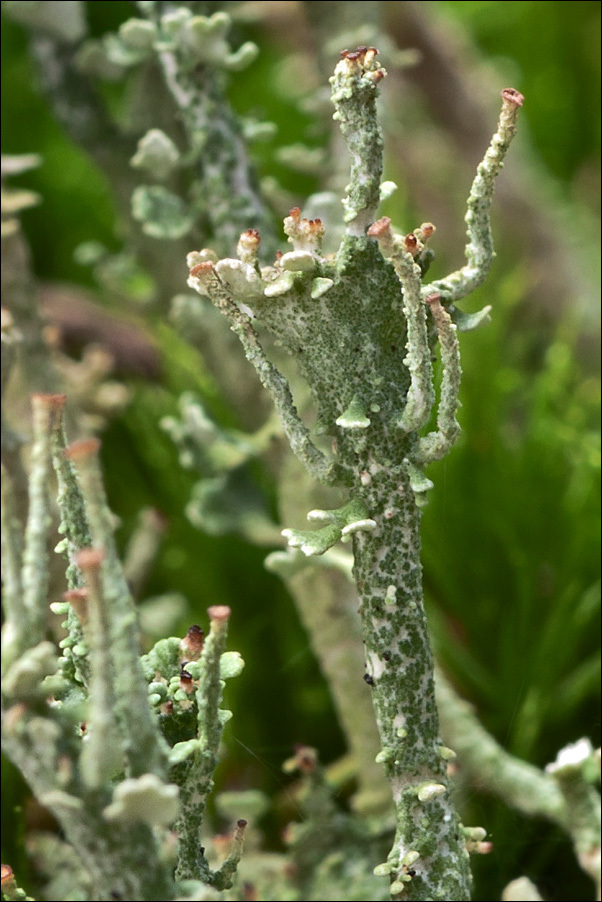
Habitat: abandoned stony pasture, moderately southeast inclined mountain slope with some Picea abies and Corylus avellana bushes, overgrown calcareous, stony ground, however possibly somewhat acid; very shallow soil layer, more or less open place, but mostly in shade of high Picea abies trees,exposed to direct rain, average precipitations ~ 3.000 mm/year, average temperature 7-9 deg C, elevations 590 m (1.950 feet), alpine phytogeographical region. - Substratum: stony ground, among low grasses and mosses. - Comment: Determined by habitus and habitat only. No chemistry tests done. This species is very variable according to literature. Usually published pictures show much less podetia squamules and less branched habitus. Hence I have doubts the determination is correct. On other side. Ref.:(1) shows very similar habitus. Also I was unable to find a better alternative with characteristically almost absent ground squamules and typical 'cups' of the podetia. - Ref.: (1) W. Rothmaler, Exkursionsflora von Deutschland, Vol.1, Niedere Pflanzen, Elsevier, 3. Auflage (1994), p 604. (2) C.W. Smith, et all, The lichens of Great Britain and Ireland,The British Lichen Society (2009), p 329. (3) F.S. Dobson, Lichens, The Richmonds Publishing Ca. LTD (2005), p 140. (4) V. Wirth, Die Flechten Baden-Wrttembergs, Vol.1. Ulmer (1995), p 327.
-
Troldsting S.f. Bulbjerg, Jylland, Danmark
-
-
-
Als Odde ved Mariager Fjord, Danmark
-
Als Odde ved Mariager Fjord, Danmark
-
Als Odde ved Mariager Fjord, Danmark
-
Als Odde ved Mariager Fjord, Danmark
-
Als Odde ved Mariager Fjord, Danmark
-
-
-
-
-
-
-
-

